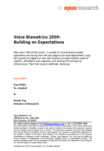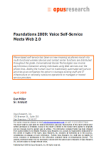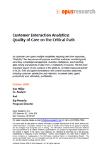Featured Research The forces of human nature, technological progress and regulatory stricture are converging to boost interest in “truly hands-free” mobile applications. Dozens of firms have responded with a broad variety of software, services and features that work remarkably well…. Read More ›
Reports
Voice Biometrics 2009: Building on Expectations

Featured Research
After years “behind the curtain,” a number of voice biometrics-based applications are moving from the pilot stage to full-scale deployments. Long-term growth will depend on how well solutions providers address issues of usability, affordability and integration with existing IVR and security infrastructure. Their track record is definitely improving.
Featured Research Reports are available to registered users only.
For more information on becoming an Opus Research client, please contact Pete Headrick (pheadrick@opusresearch.net).
Foundations 2009: Voice Self-Service Meets Web 2.0

Featured Research
Phone-based self-service has taken on new meaning as phones morph into multi-functional wireless devices and contact center functions are distributed throughout the globe. Conversational Access Technologies now involve asynchronous interaction among individuals using Web services over the phone lines. Adding the human touch to traditionally automated self-service activities gives companies the option to leverage existing staff and IT infrastructure or outsource operations to managed or hosted service providers.
Featured Research Reports are available to registered users only.
For more information on becoming an Opus Research client, please contact Pete Headrick (pheadrick@opusresearch.net).
Customer Interaction Analytics: Quality of Care on the Critical Path
 As customer care spans multiple modalities requiring real-time responses, “Analytics” has become an all-purpose word that embraces monitoring and recording, knowledge management, business intelligence, word spotting, data mining and analysis of data from a multiplicity of sources. Yet the most important aspect of new systems is the ability to correlate measured activity in ACDs, IVRs and agent workstations with overall business objectives, including customer satisfaction and retention, increased sales, agent productivity and, ultimately, profitability.
As customer care spans multiple modalities requiring real-time responses, “Analytics” has become an all-purpose word that embraces monitoring and recording, knowledge management, business intelligence, word spotting, data mining and analysis of data from a multiplicity of sources. Yet the most important aspect of new systems is the ability to correlate measured activity in ACDs, IVRs and agent workstations with overall business objectives, including customer satisfaction and retention, increased sales, agent productivity and, ultimately, profitability.
Four Steps Leading to the intelligent Customer Front Door™

In this report, commissioned by Genesys Labs, Opus Research enumerates the steps it takes to install and maintain an intelligent Customer Front Door (iCFD). A key finding is that virtually every firm that has invested in resources to improve their customers’ self-service and agent-assisted experiences has already started along a well-blazed and relatively short path to measurable improvements in the quality of customer care and, ultimately, profitability.
Featured Research
Customer loyalty is a two-way street. Businesses around the world are finding greater success at winning, serving and retaining customers when they are able to respond quickly and effectively whenever they call. intelligent Customer Front Door™ (iCFD) is a metaphor that describes a set of applications and technological resources that enable businesses to identify callers and quickly aggregate information about them to assist in successfully resolving their needs. Implementing the iCFD is an incremental process that involves integrating self-service and intelligent routing with contact center applications. Many firms are farther along than their managers might think in terms of implementing iCFD. This document illustrates a simple set of “steps toward iCFD” to help you locate your progress and readiness for full-blown implementation.
Reports are available to registered users only.
Please click here to login.
Customer Care On Demand: Speeding Deployment Cycles While Reducing Risk
Enterprises of all sizes use third-party outsourcers to support their customer care efforts in the most cost-effective ways possible. In the wake of downsizing or “right-sizing” in the IT department, many lack the resources to support self-service applications over the phone. In this document, we look at the strategies and tactics followed by hosted service to accelerate the time it takes to deploy new services while reducing the technological risk of making the transition to IP-based networks and new delivery platforms.
Contextual Communications for the Mobile Masses
The concept of unified communications (UC) is so overused it crowds out expansive thinking about the services that enterprises and wireless subscribers will use every day. The real deal is more accurately called “contextual communications,” and refers to intelligent handling and support of communications, interactions and transactions in the most appropriate manner based on analysis of each caller’s situation, including support of voice, text, graphics, video in real-time or asynchronously.
Voice Biometrics 2008: Meeting Implementation Challenges
Sales of voice biometric-based solutions took a trajectory that was bound to disappoint in 2007. While there continue to be solid sales of enterprise solutions (primarily password reset) across multiple verticals and business sizes, the breakthrough to mass market, customer-facing solutions has been elusive. In the coming years, stepped up security requirements, coupled with the growth of mobile data access and commerce, will propel demand for voice-based authentication solutions and services. Thus far the speed of adoption has been slowed by confusion over technical approaches and concerns about competition or compatibility with existing infrastructure and protocols.
CAT in 2008: Transition Without Disruption
In a year that has the scent of recession, enterprise investment in Conversational Access Technologies (CAT) will be more closely linked to business objectives than ever. This puts a premium on packaging and marketing efforts that improve users’ experience by leveraging existing self-service resources and fostering strong relationships with integrators, developers and managed service providers.
The ‘411’ on Mobile Directory Assistance: New Consumer Survey Findings
This is a transformative period for directory assistance (DA) service providers and callers alike. Call volumes are skewing toward mobile devices and competitive threats exist in the form of mobile Internet search, downloadable mapping applications and free DA alternatives. These competitive challenges raise strategic and tactical questions for mobile carriers and their service providers (about pricing and content) in the near term. The findings of a new Local Mobile Search consumer survey, sponsored by V-Enable, present a snapshot of mobile DA usage and of an industry very much in transition.

